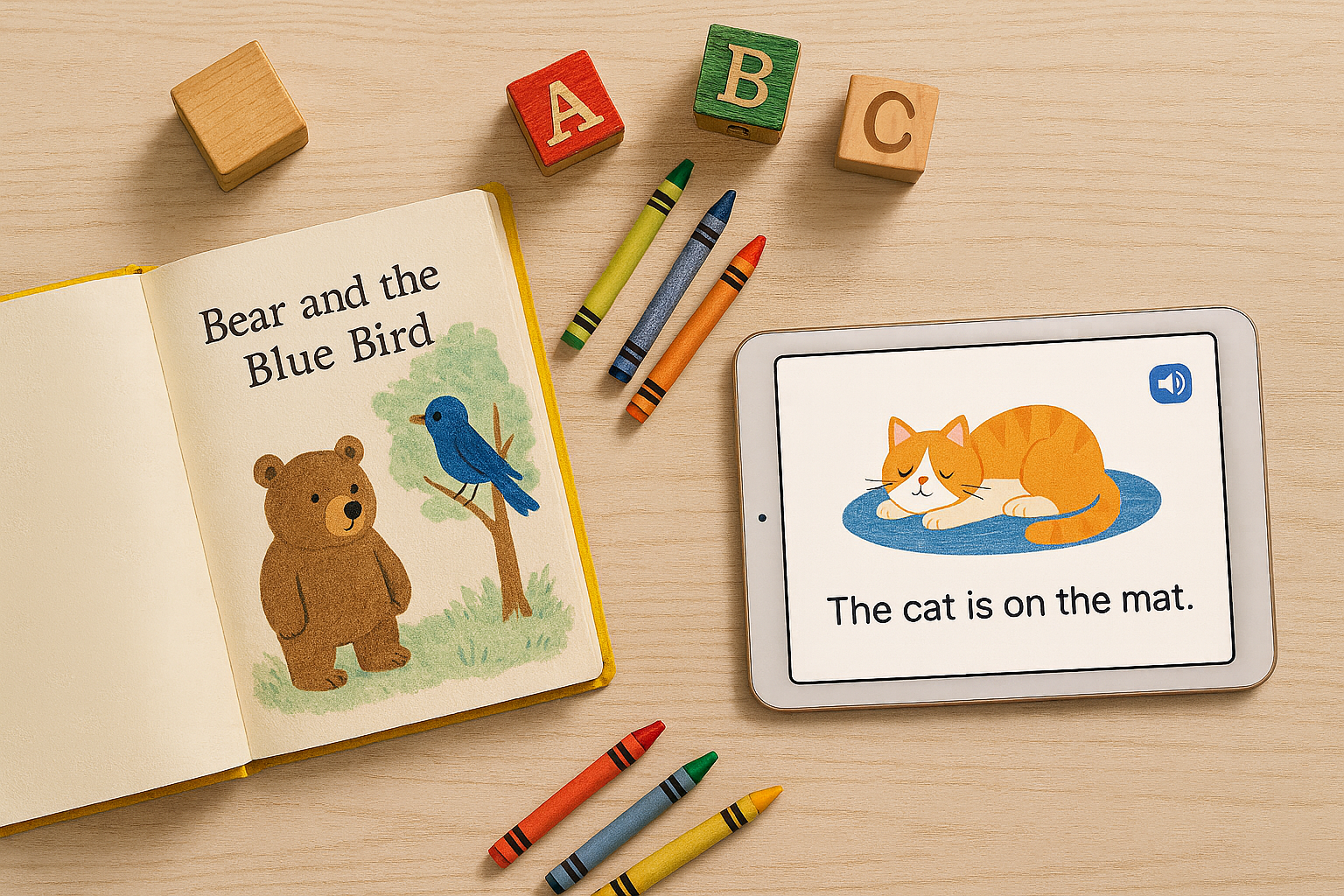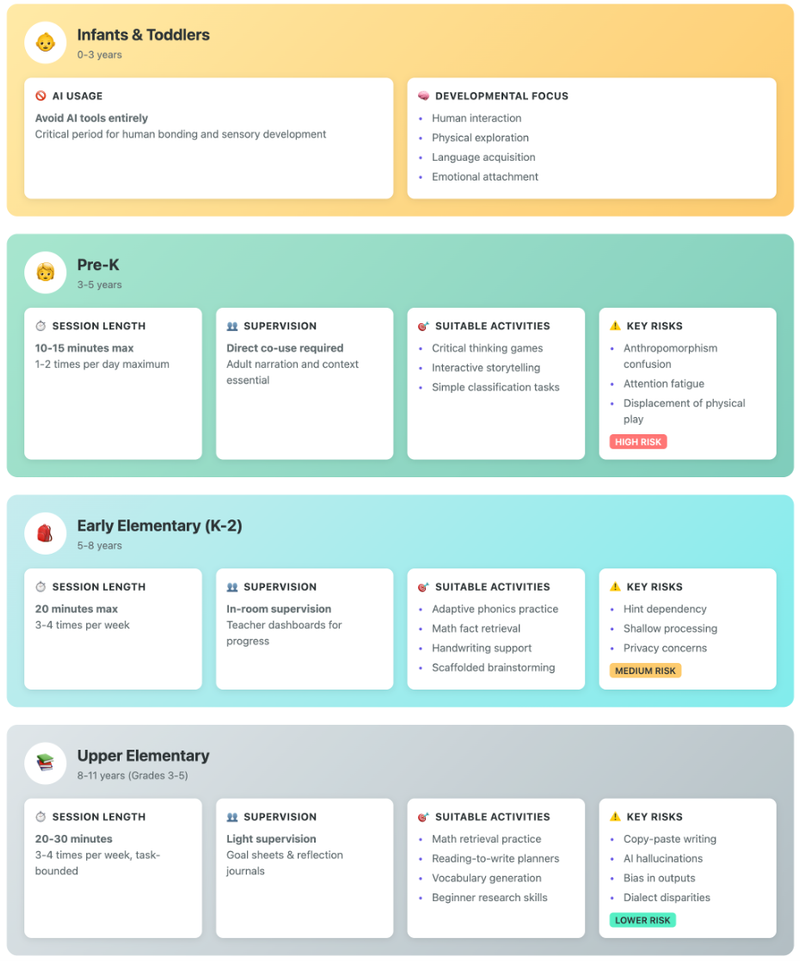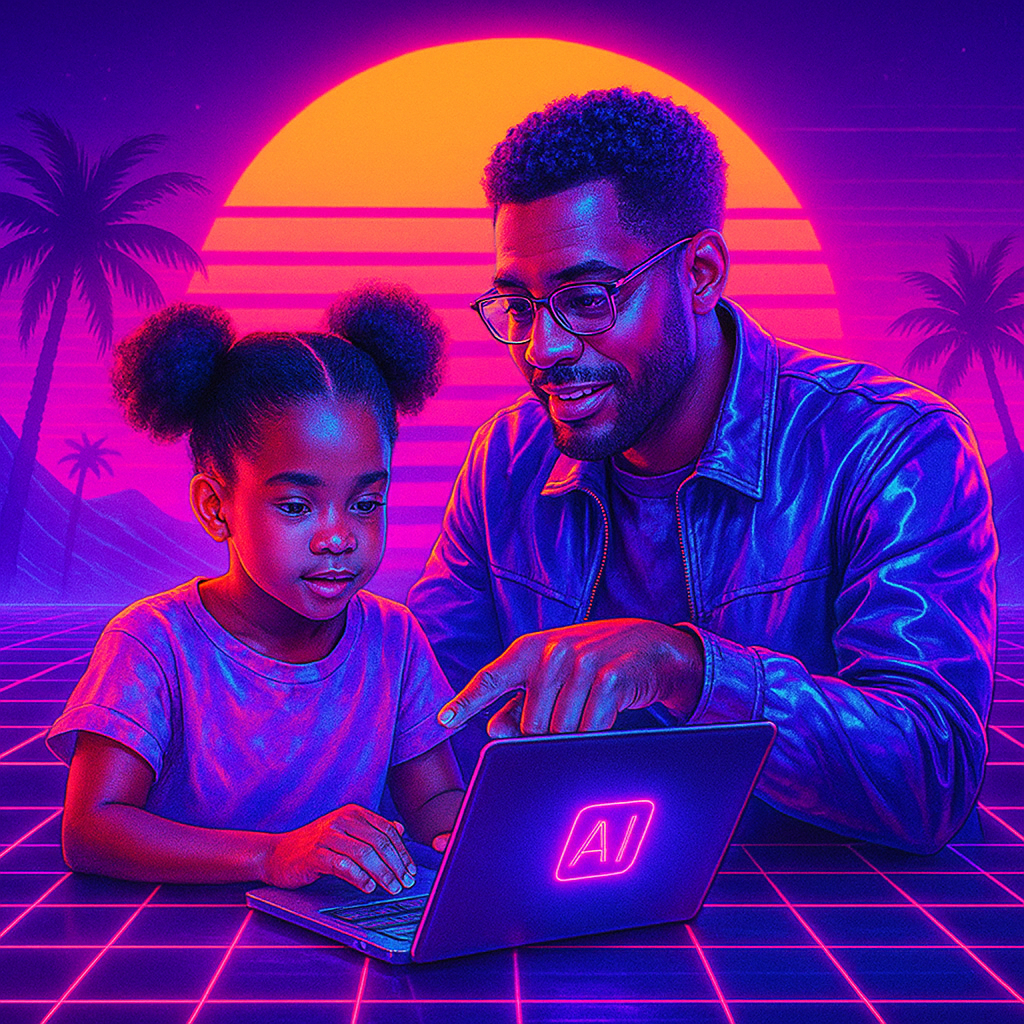When Should Kids Meet AI? A Developmental Roadmap for Parents and Schools

My daughter just started kindergarten with an iPad in her backpack. I had to take a step back and appreciate how fast time flies and changes. Three decades ago, while I was mastering the art of eating paste and practicing how to hold a crayon at her age, she's navigating touchscreens and leveraging digital learning frameworks. This is modern parenting, where we're teaching our kids to tie their shoes and preparing them for a world where AI will be as ubiquitous as oxygen by the time they're ordering their first legal beer. Invisible, essential, and taken for granted.
Inside a Child’s Developing Mind
Executive Function is King
Let’s think about what’s happening underneath the hood of your kid's head. We're looking at three key players:
- Inhibitory control (the ability to resist ice cream)
- Working memory (juggling multiple thoughts)
- Cognitive flexibility (pivoting when Plan A goes sideways).
Research published in the Annual Review of Psychology shows these capabilities develop on a predictable timeline, with major leaps around ages 3-5 and again at 7-9. If a child hasn't developed these core skills, an AI tool can become a source of distraction, not learning. If a four-year-old gets instant hints from an AI tutor, they're not building inhibitory control. They're learning dependency, not patience.
Language First
Then there's language development. The window for phonological awareness—the ability to hear and manipulate sounds in words—begins to develop around ages 3-5. It requires a "serve-and-return" interactions, analogous to a linguistic tennis match between child and parent – a child says something, parent responds. An AI can serve, but it can't truly return. It's like playing tennis with a ball machine—technically functional, deeply unproductive.
Human Connection
Next, there’s anthropomorphism. Young children can naturally assign human qualities to objects (my daughter has her piggy). When we introduce AI assistants that say "I think" or "I feel," children can form attachments to an AI, leading to confusion. MIT researchers found that kids under 8 couldn't reliably distinguish between what Alexa "knows" versus what it can access from the internet.
Attention Spans are Finite
Meanwhile, attention span research shows that sustained attention in K-2 students maxes out at about 15-20 minutes for novel tasks. Yet if we're putting them in front of AI tutors for 30-45 minute sessions, encourages shallow processing instead of deep engagement
Where AI Can Actually Help
With everything said, I believe AI has legitimate uses in early education. The key is keeping the scope tighter than your budget after the holidays.
For the Developing Reader
AI-powered tools like Amira Learning can listen to a child read aloud and provide real-time, personalized tutoring. It’s tailored as an assistant that can help a student work through phonics challenges and analyze their speech at an elemental level. Tools like Ello use animated characters to make an engaging learning experience, transforming what can be a frustrating process into a game and building a child's confidence.
For the Emerging Writer
The dread of the blank page is real. We've all been there. Fortunately, AI can be a powerful writing coach. Tools like Pressto help kids structure their ideas with clickable text blocks, overcoming the inertia of starting. Others, like LittleLit, offer a creative partner that guides children through the writing process while emphasizing AI safety and skill development. It's about augmenting the creative writing process, not automating it.
Supporting Diverse Learners
Special education is where AI truly shines. Text-to-speech tools for dyslexic students (Read&Write) and a plethora of AI Tools for Special Education—these aren't replacements for specialized instruction, they're complementary force multipliers for already excellent teaching.
Hidden Costs of AI Tutors
For every upside, there’s the risk that we must acknowledged and proactively managed. Not everything is all sunshine and rainbows as people selling it would have you think.
Screen Time and Opportunity Cost
I have seen enough Pepa Pig to know that screen time displacement can be a challenge. The American Academy of Pediatrics guidelines are crystal clear: no screens before 18 months, limited co-viewing until 5. In addition to screen time, we need to consider what the screens replace. Every minute with an AI tutor is a minute not spent in imaginative play, physical exploration or the confrontation of boredom where creativity can flourish. These are the opportunity costs children potentially pay for leveraging AI tools.
Privacy is Paramount
The privacy situation is a dumpster fire in a hurricane. Common Sense Education's 2019 State of EdTech Privacy Report found that educational apps collect an average of 10 data points per minute of use. That’s data related to keystroke patterns, response times, error rates—all fed into profiles that follow kids longer than their vaccination records. COPPA and FERPA offer some protection, but enforcement is about as robust as my hairline on Fridays.
Bias and Blind Spots
Then there's the bias problem. AI models are only as good as the data they’re trained on and they can amplify stereotypes and often perform unevenly across different dialects or accents. A study found that AI reading apps were 35% less accurate at recognizing African American Vernacular English. We have to be cognizant to not teach some kids that their natural speech is "wrong."
The Dependency Trap
The anthropomorphism issue goes deeper than confusion—it's about emotional attachment. Kids are forming parasocial relationships with AI tutors, preferring them to human teachers because they're "nicer" and "never get frustrated." That's not a feature; it's a bug in human development.
AI tools with unlimited hints and instant feedback are creating a generation that expects immediate gratification in learning. When these kids hit concepts that require sustained struggle—long division, essay writing, scientific reasoning— this is the educational equivalent of ice skating uphill.
The Guardrail Principles (Tool, Not Tutor)
Acknowledging these risks isn't about fostering fear; it's about establishing boundaries and constraints. With a clear framework, we can harness AI's benefits while mitigating risks. Here's the playbook I'll be using:
Adult-mediated introduction is non-negotiable
For K-2 students, AI use should be a joint activity. Co-viewing and co-using the technology allows an adult to frame the experience and provide context. Think sports commentator, not surveillance camera.
Frame it right from the start
Call it a "calculator for words" or a "practice robot," never a teacher or friend. Kids need to understand they're using a tool, not building a relationship.
Default to data minimization
Opt-in only, local processing when available and regular data purges. If an app needs cloud processing for basic phonics, find another app.
Tight task scopes with explicit end conditions.
AI sessions should be brief, task-oriented and no open-ended chat functions. The NAEYC & Fred Rogers Center's position statement on technology in early childhood aligns with this strategy- structured, purposeful use only.
To make this more concrete, here is a breakdown of my plan for AI usage by stage:

The Bottom Line
Here's what 81% of workers are discovering as AI reshapes their jobs: the technology is forcing us to become more human, not less. The same principle applies to our kids. AI should handle the computational grunt work, freeing children to do what humans do best—imagine, connect, create, and care.
We're not preparing our kids for a world without AI. We're preparing them for a world where being distinctly human is the only competitive advantage left. That means introducing AI based on developmental readiness, not marketing pressure or administrative convenience.
Remember: Milestones, not birthdays. Practice, not proxy. People before platforms.
My girls watch me lift heavy weights periodically. I always tell them that champions are made when no one if looking. The struggle of overcoming challenges and becoming the best version of oneself is a grueling process that they see me performing in real-time. So every time you're tempted to hand your kid a tablet with an AI tutor, ask yourself: Is this expanding their capabilities or replacing their struggles? Because in the end, it's the struggles that build strength, not the shortcuts.
The technological game has changed, but the rules of human development haven't. It's time we played accordingly.
What's your take? How are you navigating AI with your kids? Drop me a line at mdsweatt@gmail.com—I read everything, even if my response time rivals the DMV.



